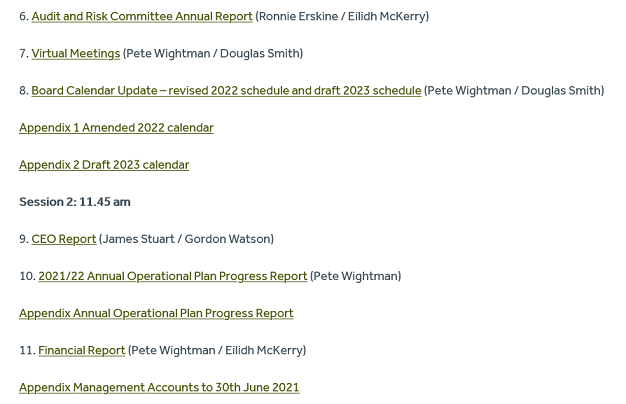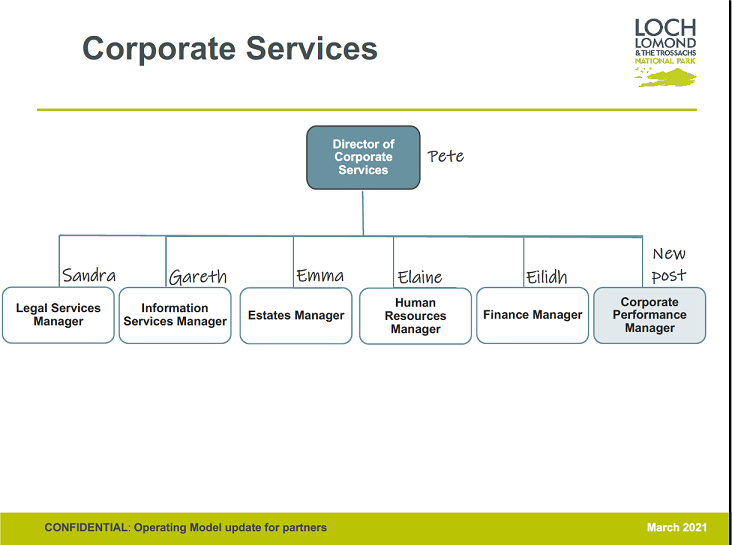The Loch Lomond and Trossachs National Park Authority Board meeting two weeks ago was only the second I have not observed in seven years. There appeared no point. The whole agenda (see here) was based on corporate box ticking – finance reports, audit reports, corporate governance:

There was no substantive item about any of the issues that matter: the environmental crisis; the climate crisis; the impact of Covid-19 on the local economy; or the infrastructure for visitors in the National Park which faced unprecedented pressures due to Covid staycationing this summer.
The LLTNPA is doing some things on these issues of course but the decisions about them are being taken by staff and not by the Board. Decisions are not, as a consequence, made in public but rather noted in various corporate documents that are then rubber stamped by the Board. That leaves Board Meetings with very little to discuss, hence why the meetings are only worth observing if you want to understand how little democratic control there is in the National Park.
A new manager to control the Board
In April, I questioned the number of new managers that the LLTNPA was appointing with the extra £3 million it was had been awarded by the Scottish Government (see here). It turns out that the list of managers in corporate services was not complete:

The most recent addition to the structure is a new Board and Committee Manager, Douglas Smith – the title says a lot – who appears to have replaced the former Committee Clerk. He, together with the Director of Corporate Services, Pete Wightman, was the author of two papers presented to the meeting for endorsement.
The first was on virtual meetings. It recommended that, once the provisions of the Coronavirus Act expire on 30th September, the facility for Board Members to participate in and for the public to observe statutory Board Meetings (i.e the Main Board, Planning and Risk and Audit Committees) virtually should continue. While this will particularly help Board Members who live in England, not least by helping to reduce their “travel related financial costs and carbon emissions”, it will also mean the public can continue to observe these meetings without attending in person. That is positive. Public attendance at the main Board Meeting has increased from 3-4 (in my experience) to an average of 11 (according to LLTNPA staff) since the meetings were livestreamed.
The paper explains the reasons for this: more members of the public, “who may not have been able to attend in–person meetings due to their location, time constraints, or physical abilities“, have been “reached” by livestreaming. However, the paper then ignores the obvious conclusion, that if webcasts remained available for a period of time after meetings even more people could be reached! I have been calling on the LLTNPA to follow the example of other public authorities and publish their meetings as webcasts for several years now. I also wrote formally to the Convener, James Stuart, suggesting this only to be rebuffed, with him claiming that no-one else was calling for meetings to be recorded.
Perhaps one of the councillors on the Board from Perth and Kinross or West Dunbartonshire Councils, both of which now make recordings of their meetings available, argued at the meeting that the LLTNPA should do the right thing and record their meetings? If not, I hope the new Minister for National Parks, Lorna Slater, will intervene.
The second paper was a schedule of future Board meetings, not just for next year but also for 2023!:

The key thing to note here is that the Board (yellow) is scheduled to meet just four times a year and one of those is a private “strategic” session. Just three meetings to take decisions, each of which is then stuffed with governance papers (finance reports, annual reports, corporate plan etc – in effect staff seeking endorsement for decisions already made – leaving no room for the main Board to decide anything.
By contrast the Futures Group, which was set up a year ago and as a non-statutory committee and meets in secret, has six meetings scheduled (dark blue) and another six dates (light blue) earmarked if they are needed. The idea behind the Futures Group – getting Board Members involved in considering issues early on – is not all bad (and I will consider what it’s being doing in another post) – but in my view the papers it has been considering, like sustainable transport, should have gone to the main Board. It has become another means by which staff sideline the main Board.
The continued failure to deliver – £200k cashback to the Scottish Government
Despite all the new managers, the finance report for April – June (see here) revealed that “we
have identified £200k of uncommitted capital as noted above that could be re–allocated by SG [Scottish Government] if needed”. This is money that appears to have been awarded to help the LLTNPA make its operations carbon neutral but already, in the first quarter of the new financial year, LLTNPA senior management have decided they can’t spend it. Extraordinary! Having failed to consult the LLTNPA Board on how to spend the extra capital allocation, staff have now decided to return it. This was not even a recommendation, the Board were asked to note the contents of the paper.
Even if ring-fenced to reduce carbon emissions, had the LLTNPA asked local communities or recreational organisations for ideas of how to spend £200k this year, they might have received dozens of ideas from insulating community halls to creating new paths – enabling people to ditch the car. Sadly, the overriding priority of senior staff at the LLTNPA appears to be keeping their sponsorship team at the Scottish Government happy.
Keeping key issues out of sight of the public – what is the point of the Board
There were three issues that really matter which were reported to the Board Meeting but, instead of being considered as papers in their own right, they were tucked away in the Chief Executive’s Report:
- visitor management (a report will be made to the December Board Meeting by which time it will be too late for the Board to change anything);
- two very important legal cases on access, about which more anon (all credit to the LLTNPA’s Access Team for this but why doesn’t access deserve a place on the agenda?); and
- water safety on Loch Lomond which I will consider in my next post.
In the two and a half years since I blogged (see here) about the need for the Board to take back control from staff, the evidence suggests the opposite has happened and staff have gained even more control over the Board. Perhaps its time the Board once again consider abolishing themselves, as a number of members to their credit proposed four years ago (see here), or failing that write to the Minister for National Parks and ask for help?
It remains to be seen if Lorna Slater will get a grip on the National Parks or if she will simply settle for the status quo in order to preserve her post in government. If she is as ‘green’ as she professes, she needs to prove it with actions.
Interesting article. The first part of it about corporate box ticking did remind me of the recent National Parks review in England. The authors of the review were quite critical on this issue. They did some analysis on NP Board Agendas and found the same thing. Lots on audit, finance, corporate governance and staffing but much less on substantive issues around conservation, recreation, access and the challenges of the climate emergency. The question must be is the weight of corporate governance worth suffering for what is actually delivered on the ground?